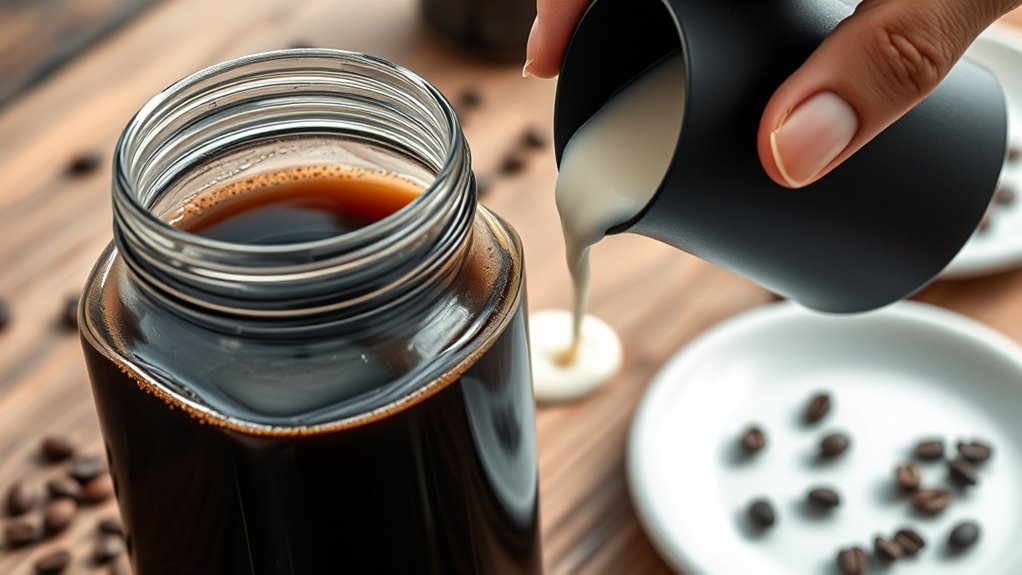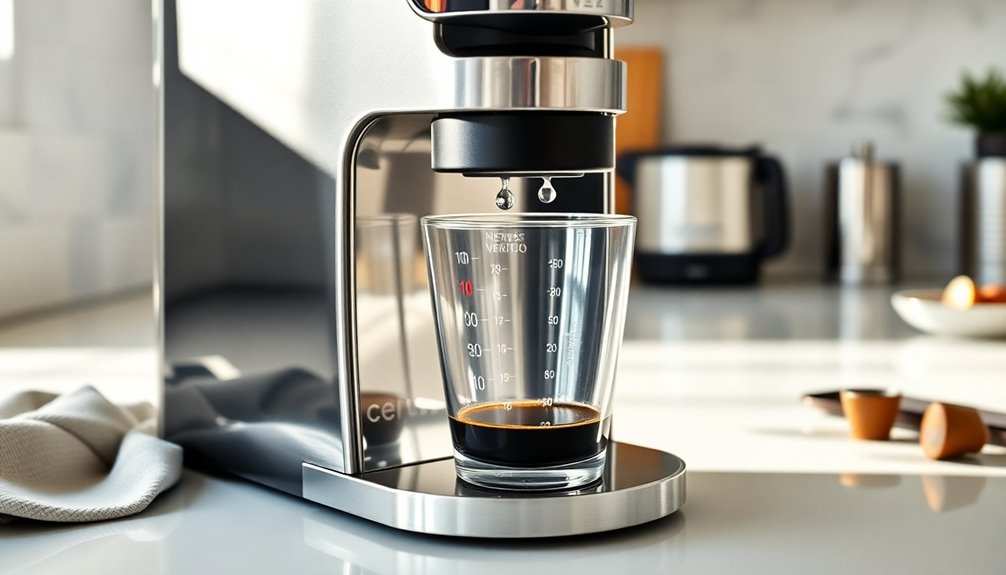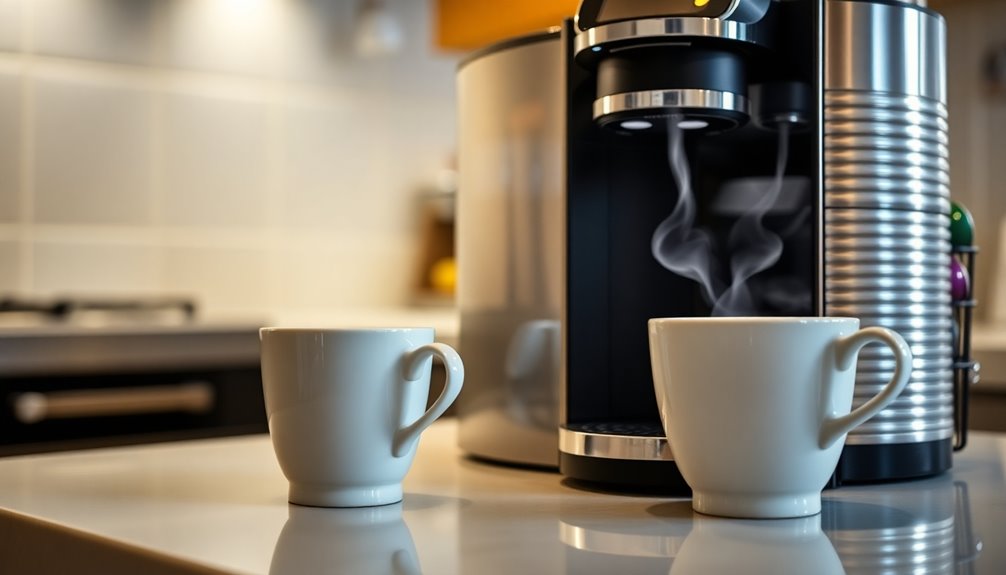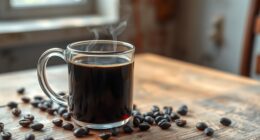Stop relying on bad habits like using overly fine grinds, hot water, or skipping proper ratios and filtration. Instead, opt for coarse grinding, controlled steeping times, and accurate measurements to get smooth, balanced cold brew. Always perform a final strain before serving and store it properly in the fridge. These steps assure better flavor and clarity every time. Keep going, and you’ll discover more tips to elevate your cold brew experience.
Key Takeaways
- Stop using pre-ground coffee; grind fresh beans just before brewing for maximum flavor and aroma.
- Avoid over-steeping your cold brew; stick to recommended times (around 12-24 hours) to prevent bitterness.
- Do not rely on overly fine grinds; opt for coarser, uniform particles to ensure smooth extraction.
- Don’t skip proper filtration; use quality filters or coffee socks for clarity and sediment-free brew.
- Refrain from storing cold brew at room temperature; always refrigerate to maintain freshness and prevent spoilage.
Relying on Overly Fine Grinds

Using overly fine grinds for cold brew can lead to a sluggish extraction process and result in a bitter, over-extracted flavor. When your grind isn’t consistent, the finer particles tend to over-extract, making your coffee harsh and unpleasant. A uniform grind ensures even extraction and helps control the brewing process. Additionally, grind size interacts with brewing temperature; colder water extracts flavors more slowly, so a too-fine grind compounds this issue by releasing bitter compounds prematurely. To avoid this, stick with a coarser, consistent grind that matches your brewing temperature. This balance prevents over-extraction, keeps your cold brew smooth, and lets you enjoy the natural sweetness and rich flavors of your coffee. Proper grind consistency and temperature control are key to a perfect cold brew.
Using Hot Water for Cold Brew

While cold brew typically involves steeping coffee grounds in cold water, some enthusiasts experiment with hot water to speed up the extraction process. Using hot water for cold brew, known as hot water extraction, can considerably shorten brewing time and enhance flavor development. When you start with hot water, the heat helps dissolve coffee solubles more quickly, resulting in a richer, more flavorful brew in less time. However, it’s important to control the temperature carefully to avoid over-extracting bitter compounds. This method can also boost flavor enhancement by highlighting different aromatic compounds compared to traditional cold steeping. Just be mindful not to use boiling water, as extreme heat can lead to a harsher taste. Instead, opt for hot, but not boiling, water to optimize flavor and efficiency. Additionally, understanding Gold IRA options can help diversify your investment portfolio if you’re exploring alternative assets beyond coffee.
Oversteeping for Extra Strength

While it might seem tempting to steep your coffee longer for a stronger brew, oversteeping can lead to bitter, unpleasant flavors. Knowing the proper steeping times helps you avoid these risks and achieve the perfect strength. Let’s explore how to balance steeping duration for great-tasting cold brew every time. Proper tableware selection for serving your cold brew can also enhance the overall experience, making it more enjoyable and visually appealing.
Risks of Oversteeping
Oversteeping your cold brew to achieve extra strength can backfire, leading to bitter, overly astringent flavor that overwhelms the smoothness you’re aiming for. The oversteeping risks stem from extracting too many compounds from the coffee grounds, resulting in a harsh taste. While longer steeping might seem beneficial, it actually causes undesirable flavor extraction, including bitterness and astringency. This over-extraction diminishes the balance and richness you want in your cold brew. Instead of risking these flavor issues, focus on precise steeping times and proper grind size. By doing so, you control the flavor extraction process, ensuring your cold brew remains smooth, flavorful, and enjoyable without the unpleasant aftertaste that comes from oversteeping. Additionally, understanding coffee extraction principles can help you optimize your brewing technique for the best flavor profile.
Proper Steeping Times
To achieve a stronger cold brew without risking bitterness, it’s essential to stick to ideal steeping times. Oversteeping can lead to undesirable flavors, so monitoring the steeping duration is key. Typically, a longer steep increases strength but requires careful temperature control. Additionally, using the correct steeping duration helps prevent over-extraction that causes bitterness.
Here’s a quick guide:
| Steeping Duration | Temperature Control | Result |
|---|---|---|
| 12-24 hours | 35-40°F (2-4°C) | Rich, smooth |
| 24-36 hours | 35-40°F (2-4°C) | Extra strong |
| 36+ hours | Risk of over-extraction | Bitter, harsh |
Sticking to these times and temperature ranges ensures you get the desired strength without bitterness.
Optimal Brew Strength
If you want a bolder, more intense cold brew, extending the steeping time can boost the strength considerably. Oversteeping can be an effective way to calibrate your brew strength, but it requires careful attention to flavor balance techniques. Keep in mind that longer steeping may lead to bitterness or over-extraction if not monitored properly. To avoid this, experiment incrementally to find the ideal balance between strength and smoothness. You can also adjust grind size or coffee-to-water ratio alongside steeping time for better control. Remember, the goal is to enhance flavor without sacrificing clarity or aroma. Incorporating material durability considerations can help prolong your equipment’s lifespan as you refine your brewing process. By fine-tuning your brew strength calibration, you’ll create a cold brew that’s both robust and well-rounded, tailored perfectly to your taste preferences.
Ignoring Coffee-to-Water Ratios

Ignoring coffee-to-water ratios can lead to a brew that’s either too weak or too strong, ruining your cold brew experience. If you don’t pay attention to these ratios, your coffee may lack flavor or become overly intense. To get it right, measure your coffee and water precisely—typically, a standard ratio is about 1:4 or 1:5. Adjusting the grind size is equally important; a coarse grind ensures proper extraction without over-extraction or a gritty texture. Too fine a grind can lead to a bitter taste and slow brewing, while too coarse might result in a weak brew. Consistency in ratios and grind size helps you control the strength and flavor of your cold brew, making it taste just the way you like it. Additionally, understanding the importance of brewing techniques can further enhance your cold brew results.
Storing Cold Brew at Room Temperature

After carefully measuring and grinding your coffee, you’ll want to think about how to store your cold brew to maintain its freshness. Storing your cold brew at room temperature isn’t ideal for preserving cold brew freshness. Exposure to warmth accelerates spoilage, leading to a sour or off taste within a day or two. If you plan to enjoy it over several days, it’s better to refrigerate the brew promptly. Room temperature storage can cause bacterial growth, which affects flavor and safety. For best cold brew freshness, keep it in an airtight container in the fridge. This slows down deterioration, ensuring your cold brew stays flavorful and fresh for up to two weeks. Avoid leaving it out at room temperature for extended periods to preserve quality and safety. Using an appropriate storage method like refrigeration is crucial for maintaining the food safety and quality of your cold brew.
Using the Wrong Type of Coffee Beans

Using the wrong type of coffee beans can spoil your cold brew. Select a roast that complements cold extraction—typically medium or dark—and avoid pre-ground beans, which can lose flavor quickly. Picking the right beans guarantees a richer, more balanced cold brew experience. Additionally, choosing beans with a rustic farmhouse aesthetic can add subtle flavor nuances that enhance the overall profile.
Choosing the Right Roast
Choosing the right roast is essential for making great cold brew, as the type of coffee beans you select directly impacts flavor and extraction. Your coffee bean selection should focus on roast level choices that complement cold brewing. Light roasts deliver bright, fruity notes, but can sometimes be under-extracted with cold brew’s slow process. Dark roasts offer richer, bolder flavors and tend to extract more evenly, making them ideal for cold brew. Medium roasts strike a balance, providing nuanced flavors without overpowering the brew. Remember, the roast level choices influence not just flavor but how the beans break down during steeping. Selecting the appropriate roast ensures your cold brew is smooth, flavorful, and perfectly tailored to your taste preferences. Additionally, understanding the content creation process on platforms like TikTok can help you explore new ways to share and enjoy your cold brew recipes with a wider audience.
Avoiding Pre-Ground Beans
Pre-ground beans can compromise the quality of your cold brew because they often lose freshness and flavor quickly. When you buy pre-ground coffee, the grind consistency may vary, leading to uneven extraction and dull flavors. Fresh beans retain their aromatic oils and vibrant taste longer, ensuring your cold brew is flavorful and smooth. Using whole beans allows you to grind just before brewing, preserving bean freshness and maximizing flavor. Additionally, freshness preservation is crucial to maintaining the optimal taste profile of your cold brew. Avoid the temptation of pre-ground options, which can result in stale-tasting coffee. Instead, invest in a quality grinder and select whole beans suited for cold brew. This way, you’ll enjoy a richer, more consistent cold brew with ideal grind consistency and maximum bean freshness.
Neglecting Proper Filtration Techniques

Neglecting proper filtration techniques can markedly impact the flavor and clarity of your cold brew. Without effective filtration, fine coffee grounds can slip through, leading to a murky, gritty texture that masks the beverage’s smoothness. Using the right filtration techniques guarantees you remove sediment and oils that cloud the brew, resulting in better brewing clarity. Invest in a quality filter or a coffee sock, and strain your cold brew slowly to catch all particles. Avoid skipping this step or rushing through it, as it compromises the overall quality. Proper filtration not only improves the appearance but also enhances the taste by eliminating unwanted bitterness and residue. Incorporating filtration methods ensures a more refined and enjoyable cold brew. Take the time to filter thoroughly for a clean, crisp cold brew experience.
Adding Excess Sweeteners or Flavors

Adding too much sugar or flavoring can easily overpower your cold brew, hiding its natural richness. When you overload, you risk masking the coffee’s true taste and creating mismatched flavor combinations. Keep it balanced to enjoy the full depth of your brew without clashing notes. Understanding the divorce process can help you approach changes in your life with clarity and confidence.
Overloading With Sugar
Overloading your cold brew with too much sugar or artificial flavorings can quickly overpower its natural richness. Instead, opt for subtle adjustments that enhance flavor without masking it. Consider using sweetener alternatives like honey, stevia, or maple syrup to achieve a more refined sweetness. These options provide flavor balancing without overwhelming the coffee’s inherent notes. Be mindful of your additions; a little goes a long way. Here are some tips:
- Start with small amounts of sweetener to gauge sweetness
- Choose natural sweeteners for a cleaner taste
- Experiment with flavor balancing by adding a pinch of salt or spices
- Avoid overly processed flavorings that mask coffee’s character
Masking Coffee’s Flavor
While it might be tempting to enhance your cold brew with generous amounts of sweeteners or artificial flavors, doing so can easily mask the coffee’s natural complexity. Overdoing it drowns out subtle notes and diminishes the coffee’s unique profile. Instead, focus on enhancing aroma naturally by choosing quality beans and proper brewing techniques. If you must add flavor, do so sparingly to avoid masking flavors. Here’s a quick guide:
| Method | Effect | Tip |
|---|---|---|
| Excess sweeteners | Masks coffee’s natural taste | Use minimal sweetener |
| Artificial flavors | Overpowering aroma | Opt for natural flavoring |
| Heavy syrups | Dulls coffee’s complexity | Keep additions subtle |
Balance is key—less is more for preserving coffee’s genuine character. Incorporating specialized vacuums can help maintain the freshness and flavor of your beans longer, ensuring you get the most out of each brew.
Flavor Clashes Often
Excessive sweeteners or artificial flavors can create flavor clashes that overwhelm the coffee’s natural profile. When you add too much, you disrupt the delicate taste balance, making the cold brew less enjoyable. Instead of enhancing, these additions often mask the coffee’s nuanced notes, resulting in a muddled flavor. To maintain clarity, consider these tips:
- Use natural sweeteners sparingly, like honey or maple syrup
- Choose subtle flavorings that complement coffee’s profile
- Avoid overpowering ingredients that dominate the taste
- Focus on enhancing rather than masking the coffee’s natural essence
Achieving the right taste balance is key. Less is more when it comes to flavor additions—aim for harmony, not distraction. This ensures your cold brew remains smooth, rich, and well-rounded.
Using Thin or Inadequate Containers

Using thin or inadequate containers can seriously affect the quality of your cold brew. The container size matters because a small or overcrowded container can lead to uneven extraction, resulting in a weaker or overly concentrated brew. Choose a container that provides enough space for the coffee and water to circulate freely. Material choices are also vital—avoid thin plastic or glass that might crack or absorb odors. Opt for sturdy, opaque containers made from glass or thick BPA-free plastic to maintain flavor integrity and prevent light exposure. Properly sized and durable containers help guarantee consistent extraction and freshness. Additionally, selecting appropriate storage conditions can further preserve the quality and flavor of your cold brew. Investing in quality containers not only improves your cold brew’s taste but also extends its shelf life, making your brewing process more efficient and enjoyable.
Skipping the Final Strain Before Serving

Skipping the final strain before serving can cause your cold brew to have a gritty or cloudy texture. Without this step, loose coffee grounds remain, affecting serving clarity. To guarantee a smooth, appealing drink, always perform the final strain. This step:
- Removes residual coffee grounds and sediment
- Enhances the visual appeal of your cold brew
- Prevents a gritty mouthfeel
- Ensures a clean, crisp flavor with every sip
- Proper straining techniques are essential for achieving optimal clarity and flavor in your cold brew.
Neglecting the final strain compromises the overall quality, making your cold brew less enjoyable. By taking this simple step, you achieve a clearer, more refined beverage that showcases the rich flavors without distraction. Remember, a thorough final strain is essential for achieving ideal serving clarity and a satisfying cold brew experience.
Frequently Asked Questions
How Can I Improve Cold Brew Flavor Without Over-Extraction?
To improve your cold brew flavor without over-extraction, focus on extraction control by adjusting grind size and brewing time. Use a coarser grind and shorten brew duration to prevent bitter notes. For flavor enhancement, consider adding natural flavorings like vanilla or cinnamon during the brewing process or post-brew. This way, you maintain smoothness while boosting taste, ensuring your cold brew stays balanced and delicious.
What’s the Best Container for Storing Cold Brew Long-Term?
You should store your cold brew in airtight vessels or storage containers to maintain freshness and prevent oxidation. Glass jars with tight-fitting lids are ideal because they don’t absorb odors and are easy to clean. Avoid plastic containers, which can degrade over time and affect flavor. Keep your cold brew in a cool, dark place, and consume it within two weeks for the best taste.
How Do I Choose the Right Coffee Beans for Cold Brew?
Imagine your cold brew as a canvas, and the beans as your palette. You want a harmonious blend of bean origin and roast level—light for bright, fruity notes or dark for bold, chocolaty richness. Choose beans from regions you love, like Ethiopia or Colombia, and opt for a medium roast to balance acidity and depth. Your perfect cold brew starts with beans that speak to your taste, inviting every sip to tell a story.
What Is the Ideal Brewing Time for a Smooth Cold Brew?
You should brew your cold brew for about 12 to 24 hours at a brewing temperature of room temperature or colder. Use a coarse coffee grind size to make sure the flavors extract slowly and smoothly. If you notice a harsh taste, try reducing the brewing time slightly or adjusting the grind size. Longer brews may become bitter, so experiment within this window to find your perfect, smooth cold brew.
How Do I Properly Dilute Cold Brew Before Drinking?
Like a painter blending colors, you should dilute your cold brew gently. Start by adding a small amount of water or milk—about one part liquid to two parts cold brew—and taste as you go. Use dilution techniques that suit your flavor preferences, adjusting until it’s just right. Remember, the goal is a smooth balance, so don’t rush—your perfect cold brew awaits with a simple, mindful touch.
Conclusion
Instead of making these common mistakes, try the tips that truly enhance your cold brew experience. Did you know that the perfect cold brew uses a coffee-to-water ratio of about 1:4 for ideal flavor? By avoiding overly fine grinds, hot water, and skipping proper filtration, you’ll enjoy a smoother, richer brew. Small adjustments can make a big difference—so, next time, do it right and savor every invigorating sip!










